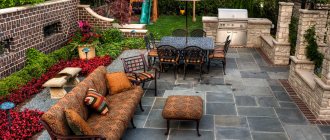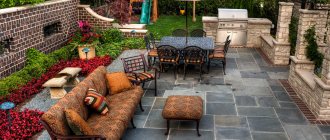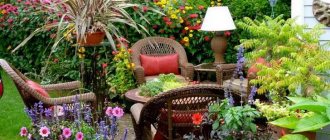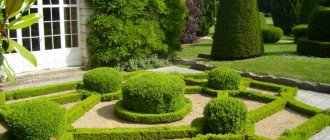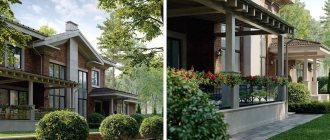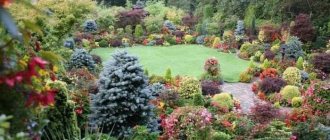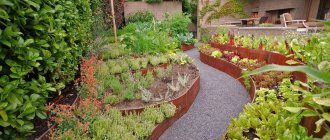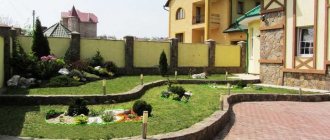One of the features and advantages of a plot of land or a household plot is the ability to improve it at your own discretion, making a small area attractive and comfortable for recreation, and revealing your creative talents. The time spent, funds invested and decoration techniques are chosen at your own discretion and fully reflect the owner’s inner world, in which he will be as comfortable as possible.
Creating your own garden on your property and improving the surrounding area is a completely feasible dream for many amateur gardeners.
Garden design (the second name is landscape design) is a composition, mainly of plants, using different styles, shapes, natural materials and decorative products in order to transform the appearance of the garden, create an atmosphere and evoke pleasant emotions in a person.
The main criterion for garden design is its style.
The garden design can be made in different styles of landscape design, formed in different cultures and over a fairly long period. Style is, first of all, the harmony of shapes, colors, and arrangement of elements necessary to create a certain picture.
French style
This garden design photo is also called classic; it is characterized by clear symmetry, straight lines and geometric shapes of the correct shape, laid down at the beginning of the design and laying process. The artificiality of forms is felt in everything, as the main way to combat the surrounding chaos. A house, fountain or lake with ideal geometry is the center of the composition and the reference point for other decorative elements.
The main goal of the direction is expressiveness.
Trees and bushes must be perfectly trimmed. One of the striking characteristics of the French style are antique sculptures, stone balls, Greek, arches, vases and bowls on columns or pedestals. Preference is given to plants with the correct structure, for example cypresses, thujas, dense shrubs with the ability to create the desired geometry. To implement a French design, you need a large space for a feeling of freedom, open space and great effort to maintain the plant mass of the desired size and shape.
Symmetrical flower beds are surrounded by small borders and decorated with sculptures of greenery or multi-colored backfill.
Decorative camouflage
The philosophy of this garden landscape design is based on ways to hide or attract attention to other objects of park elements. Shrubs, climbing plants and perennial plants will serve as decoration for the fence. Some shrubs, after a certain time, can completely replace the fence. A house can be completely transformed if its walls are partially or completely overgrown with grapes.
It is important to understand what the owner of the personal plot wants to see in the end, upon completion of the work.
A dead tree can also be hidden from public attention if its crowns do not pose a danger of a possible fall. Beautiful gardens and summer cottages with flowers, shrubs, photos with declarative camouflage will save time and minimize the fight against growing branches and leaves. This type of design can be implemented even in the smallest areas.
The style is beautiful in its own way, reflecting the inner world and preferences of the owner of the garden.
We assess the potential of the land plot
Of course, for many summer residents, their own meters of land are the best and most expensive. However, if we are talking about landscape design, as in the photo, you should evaluate your possessions a little critically.
Land plot
Landscaping
Pay attention to the age, number and condition of trees, the degree of infestation of the site with wild plants, the presence of slopes, hills and the presence of rockiness, the remoteness of natural and underground water sources, the assessment of the incidence of sunlight on different parts of the garden.
Garden plot
At the initial stage, it is worth considering that any feature of the site must be turned into your ally. For example, the same overgrown bush can be decorated in a green shield that can hide the area from prying eyes; areas with old trees can be decorated in country style; in addition, bright illustrations and photos of the design will allow you to decorate the garden with your own hands.
English style
Unlike the French style, it offers complete freedom of natural shapes and lines. The main attribute of an English garden is the lawn, which is always trimmed and well-groomed and remains green all year round due to the peculiar weather conditions of England. Along with the lawn, vertical gardening is widely used with the help of climbing plants or shrubs, which, along with the lawn, are constantly trimmed.
The design of a garden plot in the English style does not imply clearly defined lines.
The garden is surrounded by flowers, creating complex compositions from a large number of densely planted plants. Much attention is paid to the texture and colors of natural materials from which paths, benches, gazebos, and park compositions are made. Plants of different heights create levels and natural relief of the park. The garden plot and buildings form a single composition. To implement English design, you need a plot of at least 12 acres.
All paths, flower beds, arches, gazebos, along with green spaces, create a single integrity of the picture, with pleasant soft outlines and shapes.
Implementation of ideas
So, if you decide to design a garden yourself, without resorting to the help of specialists, then you should start with large-scale work - leveling, lighting, installing a drainage system, increasing the fertile layer of the site, digging a pit for a future pond, laying a lawn, etc. And only after these “foundational” works have been completed can we talk about starting to plant plants, design a recreation area, etc.
Implementation of ideas
Garden design
Even with their own efforts, everyone can turn their plot into a piece of paradise - the main thing is to awaken in yourself the desire to turn your home into a fairy tale, and interesting ideas for transforming the garden will emerge in your imagination, and if not, you can see them in the photographs presented on the site. All that remains is to implement this whole thing and create an exceptionally beautiful garden design with your own hands.
Mediterranean style
The Mediterranean is significantly different from other territories in its color and rich culture of adjacent peoples. The homeland of the Mediterranean style is Greece and Rome, which means it contains classical, strict forms and straight lines. This is the most colorful and picturesque garden of all possible plant species. It is characterized by a subtropical climate and a wide variety of flora: citrus and coniferous trees, spices, flowers of various shapes. This garden option is applicable in the southern regions, using more winter-hardy plants or creating a winter garden with the possibility of heating in winter.
Mediterranean style is a godsend for areas with complex terrain.
Under ideal conditions, evergreens are used: palm trees, lemons, oranges. There is a type of evergreen that can withstand low temperatures, such as boxwood. Gazebos and walls of the house can be decorated with climbing plants and shrubs. Stone and amphorae are widely used as park sculptures and decorative elements. Pools, fountains, cascades are an important and necessary addition to the style.
The Mediterranean garden is attractive with its richness of colors and lush plants.
Basic principles of landscape design
Landscape design transforms any summer cottage into a cozy and unique world . However, when working, it is not enough to be guided by instinct and intuition. To ensure that the result pleases you and surprises your neighbors, we recommend taking into account the basic principles on which the landscape design of your summer cottage is based.
- Integrity . Provides for the presence of several identical elements in different parts of a suburban dacha plot. They can be decorative or natural. In order to see the whole picture more clearly, they draw up a plan that defines the theme of the composition. With its help, it is easier to place landscape design elements in unity and harmony.
- Simplicity . Piling up elements or creating complex structures takes a person away from nature. What is attractive is the natural tone of the suburban area. The variegation of color also tires the eye; it is better to stop at two or three colors and play on their shades.
- The principle of balance , symmetrical and asymmetrical. With symmetrical balance, identical elements are mirrored in relation to a visually defined point. Asymmetrical balance allows form and color in their diversity, but maintaining harmony in their application.
- Plants must be combined.
- The smoothness of the transition plays a huge role: from low in the foreground to high in the background. This creates the effect of landscape depth.
Alpine style in garden design
This type of design makes it possible to create, despite possible harsh natural conditions. Any stones are suitable for an alpine slide. The resulting composition is easy to care for; no fertilizers, transplants or fertilizing are needed. The alpine landscape of the garden has a number of distinctive features:
- Terrain relief.
- No fences.
- Gazebos are in a visible and easily visible place, but lower than the location of the house.
- Plants sit between the stones.
- Much attention is paid to mosses as integral inhabitants of natural stone structures.
Alpine landscape design is relevant for all regions of the country.
The point of the alpine style is to find the best and most natural location for each stone. In addition to alpine slides, alpine ramps, podiums, paths, flower beds, etc. can be erected.
Functional areas of the garden plot
Zoning is that the area of a land plot is divided into zones , each of which has its own functional load :
- front door : people enter here or cars enter, no more than 6% of the entire site;
- recreation area : from 10 to 14% of the total territory;
- household : includes garage, greenhouses, etc.;
- playroom : a place for children's entertainment;
- gardening : up to 75%;
Some zones are combined into one space, saving space.
Rustic style (rural or country)
Village life will always attract the attention of people living in big cities. It is close to nature and is as natural as possible. Even rustic household items evoke a feeling of calm mind and peace. Sometimes you really want to be in an atmosphere where the absence of strict rules in the interior and everyday life is the norm.
Naturalness, this is precisely the feature that characterizes the rustic Country style.
Features of rustic garden design:
- Somewhat chaotic, not causing irritation.
- Paths, loosely laid with gravel, between which grass grows.
- Flowers growing in special flower beds.
- An abundance of hand-made carpentry, forged or wicker household items, gazebos, benches.
- An abundance of fruit plants and trees - pumpkins, grapes, apple trees.
High-tech style in garden design
This modern garden design is based on the influence of modern technology on our environment and consciousness and appeared thanks to the development of new materials, more durable, cheaper, with different properties and appearance.
The high-tech style involves the embodiment of the most daring ideas, unusual for other trends in landscape design.
Features of high-tech in garden design:
- Concrete, glass, metal and plastic structures of industrial production.
- Straight lines and angles, clear shapes.
- Polished glossy or matte surfaces.
- Vertical gardening.
- A well-groomed lawn of regular geometric shape.
- Park compositions and sculptures of abstract forms.
- Several levels of garden or park.
- Musical fountains.
- Comfortable gazebos and benches with the ability to charge your phone.
Here you can create optical illusions using decorative lighting, any unusual shapes.
Ecological style in garden design
Ecology plays an important role for modern people. Eco-style allows minimal interference with natural processes while preserving the natural beauty of the park. The garden space, designed in an ecological style, is a complex biological system, the elements of which are interconnected and in constant balance.
To play with pristine nature, to create your own eco-system on the site - this direction in design has been particularly successful over the past few years.
Signs of garden design made in eco-style:
- Construction materials are typical for the area and ecosystem.
- Natural relief, not modified by man.
- Combinations of wild and garden plants and trees.
- Wild plants are used for the lawn.
- The paths have a conditional meaning and can be interrupted; rather, they indicate the direction and are laid out with natural stones.
The designer’s task when creating an eco-style is to emphasize the existing landscape as best as possible and play up its features.
DIY garden design photo
DIY paradise
Corner in the garden
Decorating the garden plot
Decoration of flower beds
We create comfort with our own hands
Plant diversity
Lawn
Japanese style
The traditional garden of Japan is more than one thousand years old, is not similar to other types of landscape design, and is made under the influence of Zen Buddhism, as a path to human liberation and Shintoism - belief in the power of natural spirits. Such gardens can still be seen in Japan on the territory of temples and monasteries; they encourage meditation and contemplation. Japanese garden interior design techniques are used in full or in part to emphasize the connection between man and the surrounding nature.
In a Japanese garden, every pebble or decorative item has a special meaning, and there is a whole science involved in creating a landscaped area.
Japanese design features:
- Asymmetry is the basis for the layout and all decorative elements.
- So-called “rock gardens”, using boulders, gravel, pebbles and sand, reminiscent of miniature mountains and valleys.
- A wide variety of naturally shaped ponds or stone bowls of water.
- Step-by-step trails using boulders and cobbles.
- Using large trees with a wide crown to muffle sunlight.
- Bamboo structures of bridges, gazebos, benches.
- Traditional Japanese lanterns and deities made from unpolished stone.
All items used to create a Japanese-style garden have asymmetrical lines.
Creating a Japanese garden: step-by-step instructions
Creating a Japanese garden is an incredibly exciting process. But the complexity of the work ahead can extinguish any fuse. The step-by-step instructions below will help you bring the matter to its logical conclusion.
Step 1. Layout
You should start by assessing the characteristics of the site you have. Planning is impossible without taking into account the features of the relief. Then you need to draw up a rough plan and think through the individual elements.
Think of all the details perfectly
Step 2. Selecting stones
It is important to select samples of a uniform color scheme. The easiest option is to install the selected instances in the central part of the composition.
Remember not to pile stones on top of each other. It is better to fill the resulting voids with sand mixed with fine gravel. The combination of light sand and dark boulders looks most impressive.
Don't pile stones on top of each other
Step 3. Selection of plants
To create a Japanese garden, you can use conifers, creeping bushes, climbing plants and ground cover plants. Green plants with small leaves and discreet flowers are perfect. Dwarf plants will also look advantageous.
Green plants with small leaves and discreet flowers are perfect for a Japanese garden.
If we talk about specific examples, among the trees these are: pine, maple, sakura (can be replaced with Raksa cherry). Barberry can be used as a hedge. The optimal flowers for Japanese are peonies, chrysanthemums and rhododendrons.
Optimal flowers for a Japanese garden are peonies, chrysanthemums and rhododendrons.
Try to select plants of uniform shape, then it will look more harmonious. An area dedicated to mosses can add a note of originality.
Step 4: Organize Additional Elements
The best addition to a Japanese garden is a tea house. If creating such an element is too labor-intensive for you, you can opt for a small garden bridge. It, like most other decor, can be purchased ready-made.
The best addition to a Japanese garden is a tea house
Lighting plays a big role; if you pay attention to it, you can enjoy the beauty at any time of the day. It is best to purchase special Japanese lanterns, of which there are plenty of varieties.
Special Japanese lanterns are best for lighting.

